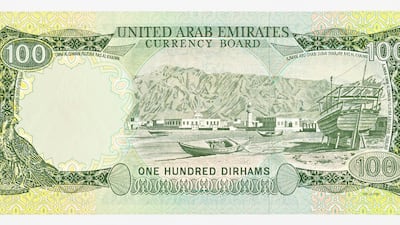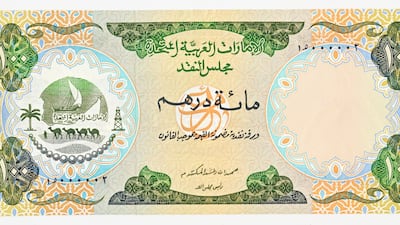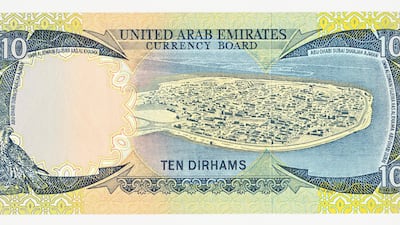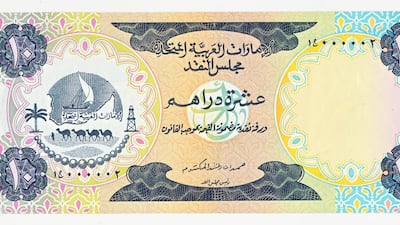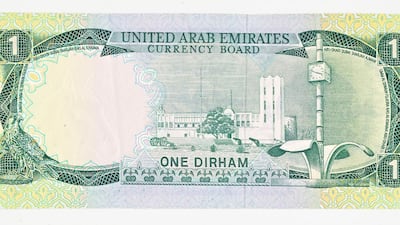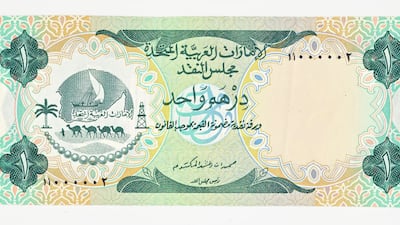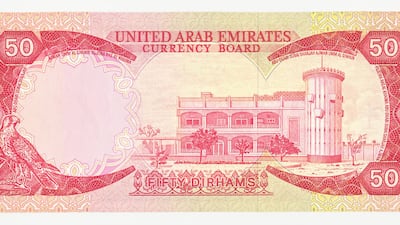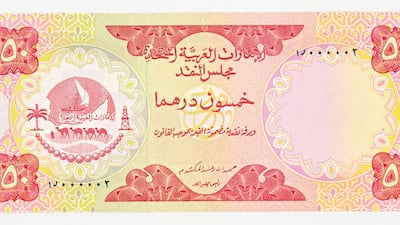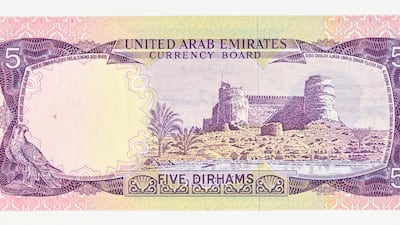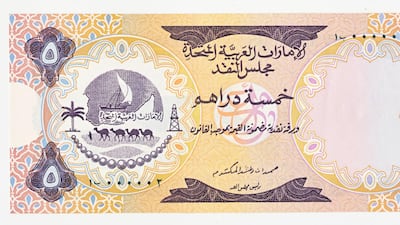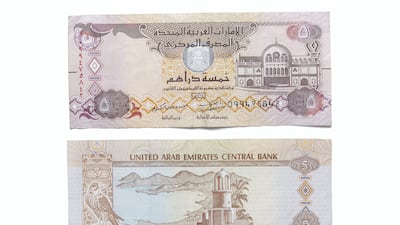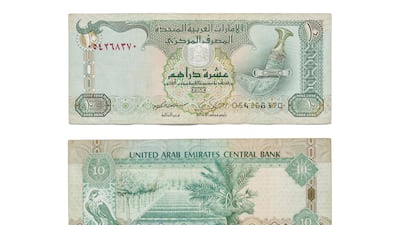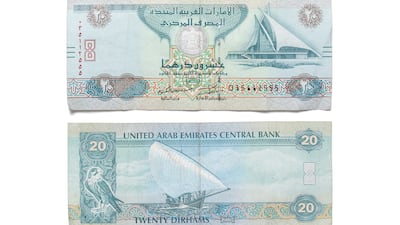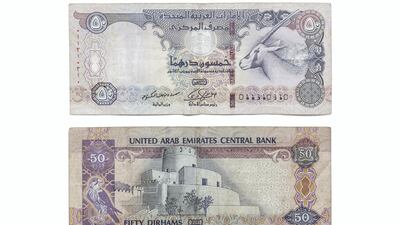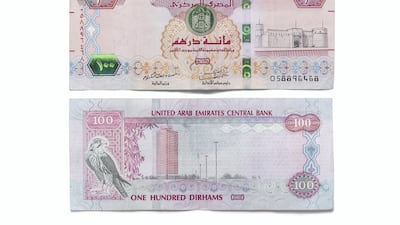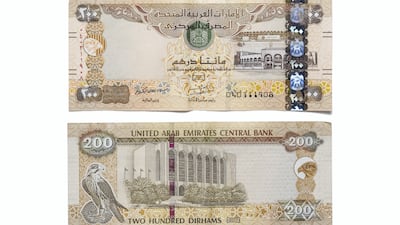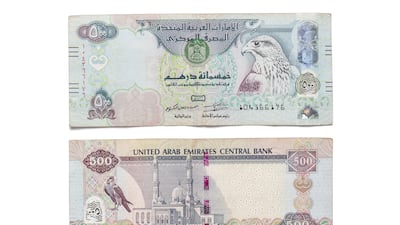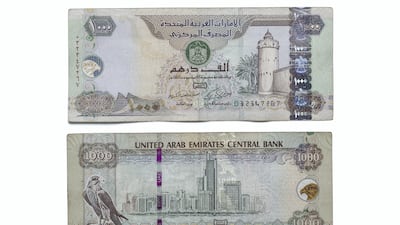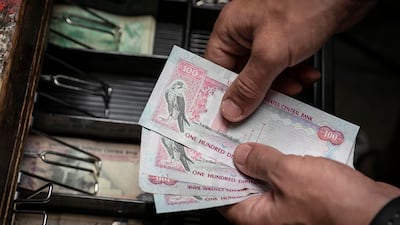It was the second week of May 1973 and, under conditions of absolute secrecy, a heavily guarded convoy of lorries wound out of Dubai International Airport.
Driving steadily west, the convoy picked up speed as it reached the empty desert of Jumeirah and crossed the border to become some of the first vehicles to use the new single carriageway that connected Dubai and Abu Dhabi.
Several hours later they reached their destination, the National Bank of Abu Dhabi. Printed in London, then flown more than 4,800km to a country not yet two years old, here, in tightly packed bricks of paper, was the wealth of a nation.
Or at least its banknotes. It is 50 years since the UAE dirham made its debut and the now familiar coins and notes became the official currency.
Quickly put into circulation
The news of the new currency had been made public only a week before it became legal tender on May 19, 1973.
It was revealed on the May 12 front page of Abu Dhabi News, the English language newspaper of the time, under the headline "New Currency for the UAE" and reporting: "The United Arab Emirates will have its own currency replacing the existing currency of Bahraini dinar and Qatar-Dubai riyal."
A fuller account came a week later in the Gulf Mirror, which revealed: "The UAE currency arrived last week in Dubai on chartered planes in great secrecy."
“All banks in the UAE were closed yesterday through to Thursday while the National Bank will send the banks, all over the UAE, the necessary amounts of new currency for their current circulation,” the paper said.
It claimed the design of the dirham had not been without controversy; “There was a dispute over printing some verses from the Holy Quran on the new currency.
“It was argued in some circles that since the currency would circulate among non-believers, it was therefore against the principles of Islam to have such verses printed.”
A money of its own
Most people, though, were glad to see the back of a confusing jumble of currencies that had existed previously, in some cases for more than a century. A country that had come together on December 2, 1971 now had money it could call its own.
Mohan Jashanmal, whose family name is familiar on shops across the Arabian Gulf, recalls that Abu Dhabi was undergoing spectacular growth by the early 1970s, the result of expanded oil production and rising energy revenue.
“Everything was turned upside down. The Corniche was being built and there were new roads everywhere.”
It created a problem. “At that time we had to have shipments to get money into the country.”
In the case of Abu Dhabi, the money being brought in was the Bahraini dinar, adopted in 1965.
For Dubai, the official currency was the riyal, the result of the Qatar-Dubai Currency Agreement of March 21, 1966.
Before that, the currency situation was even more complex. From the 19th century, many traders in the region turned to the Maria Theresa thaler, from which the name dollar is derived.
Minted from silver and bearing the head of the Austrian empress, the coin carried only the date of her death in 1780.
So popular was this universal currency that versions were minted all over the world. The Birmingham Mint in England was still striking silver thalers for use in the Middle East as late as 1955.
'The Gulf rupee'
In 1945, a British official in the Gulf noted in his annual report to superiors that: “The Maria Theresa thaler, the local currency, appreciated steadily during the year …Prices of local product have all to be paid for in this currency and the poor, especially those on low rupee salaries, have accordingly suffered.”
A solution was the widespread adoption of the Indian rupee, but its popularity put an increasing strain on India’s currency reserves, and in 1959, the Gulf rupee was introduced, printed in red and pegged to the British pound at the rate of 13.5 to £1.
Another seismic change took place in 1966. India’s increasingly perilous finances led to the government of Indira Ghandi devaluing the rupee by a staggering 57 per cent on July 6. The Gulf rupee was not spared. Anyone holding the currency was instantly poorer. The currencies of Bahrain and Qatar provided a temporary fix.
Even after the creation of the UAE, the picture was still confused. Advertisements in the local newspapers, including those for government contracts, could be in any one of three currencies, including the rupee.
A single currency was essential if the new government was to retain monetary control. And so the dirham was created, an ancient name known from the early days of the Byzantine Empire and drawn from the Greek for “handful”.
Dirham banknotes were printed in six denominations from Dh1,000 to Dh1 and embossed with local scenes and their value in Arabic and English.
The Dh1,000 note showed the Jahili Fort in Al Ain and the minaret of the Great Mosque in Dubai; the Dh1 was illustrated with the fort at Sharjah, then the police station, and the old clock tower. All carried the falcon watermark.
Coins were also minted, from a Dh1, slightly larger than the one in use today, down to a single fils, in bronze and featuring a stand of palm trees. Rarely seen these days, the coin is still technically in circulation, like its equally elusive bigger brothers, the five and 10 fils.
Mohan Jashanmal recalls the dirham arrived without any pain. Currencies in the region were valued against the US dollar, he points out, which made conversion easy. “We never had any riyal problems.”
In August 1973, the Currency Board took out newspaper advertising to warn the Qatar-Dubai riyal would cease to be legal tender by mid-September. In November, the Bahraini dinar followed suit. The mighty dirham now ruled over the UAE.
A version of this story was first published on May 17, 2018
Spec%20sheet
%3Cp%3E%3Cstrong%3EDisplay%3A%3C%2Fstrong%3E%204.7%22%20Retina%20HD%2C%201334%20x%20750%2C%20625%20nits%2C%201400%3A1%2C%20True%20Tone%2C%20P3%3Cbr%3E%3Cstrong%3EChip%3A%3C%2Fstrong%3E%20Apple%20A15%20Bionic%2C%206-core%20CPU%2C%204-core%20GPU%2C%2016-core%20Neural%20Engine%3Cbr%3E%3Cstrong%3ECamera%3A%3C%2Fstrong%3E%2012MP%2C%20f%2F1.8%2C%205x%20digital%20zoom%2C%20Smart%20HDR%2C%20Deep%20Fusion%3Cbr%3E%3Cstrong%3EVideo%3A%3C%2Fstrong%3E%204K%2B%40%2024%2F30%2F60fps%2C%20full%20HD%2B%40%2030%2F60fps%2C%20HD%2B%40%2030%20fps%3Cstrong%3E%3Cbr%3EFront%20camera%3A%20%3C%2Fstrong%3E7MP%2C%20f%2F2.2%2C%20Smart%20HDR%2C%20Deep%20Fusion%3B%20HD%20video%2B%40%2030fps%3Cbr%3E%3Cstrong%3EBattery%3A%3C%2Fstrong%3E%20Up%20to%2015%20hours%20video%2C%2050%20hours%20audio%3B%2050%25%20fast%20charge%20in%2030%20minutes%20with%2020W%20charger%3B%20wireless%20charging%3Cbr%3E%3Cstrong%3EBiometrics%3A%3C%2Fstrong%3E%20Touch%20ID%3Cbr%3E%3Cstrong%3EDurability%3A%3C%2Fstrong%3E%20IP67%2C%20dust%2C%20water%20resistant%20up%20to%201m%20for%2030%20minutes%3Cbr%3E%3Cstrong%3EPrice%3A%3C%2Fstrong%3E%20From%20Dh1%2C849%3C%2Fp%3E%0A
Abaya trends
The utilitarian robe held dear by Arab women is undergoing a change that reveals it as an elegant and graceful garment available in a range of colours and fabrics, while retaining its traditional appeal.
EXPATS
%3Cp%3E%3Cstrong%3EDirector%3A%3C%2Fstrong%3E%20Lulu%20Wang%26nbsp%3B%3C%2Fp%3E%0A%3Cp%3E%3Cstrong%3EStars%3A%3C%2Fstrong%3E%20Nicole%20Kidman%2C%20Sarayu%20Blue%2C%20Ji-young%20Yoo%2C%20Brian%20Tee%2C%20Jack%20Huston%3C%2Fp%3E%0A%3Cp%3E%3Cstrong%3ERating%3A%3C%2Fstrong%3E%204%2F5%3C%2Fp%3E%0A
The years Ramadan fell in May
The bio
Favourite book: The Alchemist by Paulo Coelho
Favourite travel destination: Maldives and south of France
Favourite pastime: Family and friends, meditation, discovering new cuisines
Favourite Movie: Joker (2019). I didn’t like it while I was watching it but then afterwards I loved it. I loved the psychology behind it.
Favourite Author: My father for sure
Favourite Artist: Damien Hurst
PROFILE OF CURE.FIT
Started: July 2016
Founders: Mukesh Bansal and Ankit Nagori
Based: Bangalore, India
Sector: Health & wellness
Size: 500 employees
Investment: $250 million
Investors: Accel, Oaktree Capital (US); Chiratae Ventures, Epiq Capital, Innoven Capital, Kalaari Capital, Kotak Mahindra Bank, Piramal Group’s Anand Piramal, Pratithi Investment Trust, Ratan Tata (India); and Unilever Ventures (Unilever’s global venture capital arm)
MATCH INFO
Uefa Champions League semi-final, second leg
Roma 4
Milner (15' OG), Dzeko (52'), Nainggolan (86', 90 4')
Liverpool 2
Mane (9'), Wijnaldum (25')
The biog
Favourite film: Motorcycle Dairies, Monsieur Hulot’s Holiday, Kagemusha
Favourite book: One Hundred Years of Solitude
Holiday destination: Sri Lanka
First car: VW Golf
Proudest achievement: Building Robotics Labs at Khalifa University and King’s College London, Daughters
Driverless cars or drones: Driverless Cars
Guardians%20of%20the%20Galaxy%20Vol%203
%3Cp%3E%3Cstrong%3EDirector%3A%20%3C%2Fstrong%3EJames%20Gunn%3C%2Fp%3E%0A%3Cp%3E%3Cstrong%3EStars%3A%3C%2Fstrong%3E%20Chris%20Pratt%2C%20Zoe%20Saldana%2C%20Dave%20Bautista%2C%20Vin%20Diesel%2C%20Bradley%20Cooper%3C%2Fp%3E%0A%3Cp%3E%3Cstrong%3ERating%3A%3C%2Fstrong%3E%204%2F5%3C%2Fp%3E%0A
All%20The%20Light%20We%20Cannot%20See%20
%3Cp%3E%3Cstrong%3ECreator%3A%20%3C%2Fstrong%3ESteven%20Knight%3C%2Fp%3E%0A%3Cp%3E%3Cstrong%3EStars%3A%C2%A0%3C%2Fstrong%3EMark%20Ruffalo%2C%20Hugh%20Laurie%2C%20Aria%20Mia%20Loberti%3C%2Fp%3E%0A%3Cp%3E%3Cstrong%3ERating%3A%20%3C%2Fstrong%3E1%2F5%C2%A0%3C%2Fp%3E%0A
Key findings of Jenkins report
- Founder of the Muslim Brotherhood, Hassan al Banna, "accepted the political utility of violence"
- Views of key Muslim Brotherhood ideologue, Sayyid Qutb, have “consistently been understood” as permitting “the use of extreme violence in the pursuit of the perfect Islamic society” and “never been institutionally disowned” by the movement.
- Muslim Brotherhood at all levels has repeatedly defended Hamas attacks against Israel, including the use of suicide bombers and the killing of civilians.
- Laying out the report in the House of Commons, David Cameron told MPs: "The main findings of the review support the conclusion that membership of, association with, or influence by the Muslim Brotherhood should be considered as a possible indicator of extremism."
Company%20profile
%3Cp%3EName%3A%20Cashew%0D%3Cbr%3EStarted%3A%202020%0D%3Cbr%3EFounders%3A%20Ibtissam%20Ouassif%20and%20Ammar%20Afif%0D%3Cbr%3EBased%3A%20Dubai%2C%20UAE%0D%3Cbr%3EIndustry%3A%20FinTech%0D%3Cbr%3EFunding%20size%3A%20%2410m%0D%3Cbr%3EInvestors%3A%20Mashreq%2C%20others%0D%3C%2Fp%3E%0A
Sholto Byrnes on Myanmar politics
Diriyah%20project%20at%20a%20glance
%3Cp%3E-%20Diriyah%E2%80%99s%201.9km%20King%20Salman%20Boulevard%2C%20a%20Parisian%20Champs-Elysees-inspired%20avenue%2C%20is%20scheduled%20for%20completion%20in%202028%0D%3Cbr%3E-%20The%20Royal%20Diriyah%20Opera%20House%20is%20expected%20to%20be%20completed%20in%20four%20years%0D%3Cbr%3E-%20Diriyah%E2%80%99s%20first%20of%2042%20hotels%2C%20the%20Bab%20Samhan%20hotel%2C%20will%20open%20in%20the%20first%20quarter%20of%202024%0D%3Cbr%3E-%20On%20completion%20in%202030%2C%20the%20Diriyah%20project%20is%20forecast%20to%20accommodate%20more%20than%20100%2C000%20people%0D%3Cbr%3E-%20The%20%2463.2%20billion%20Diriyah%20project%20will%20contribute%20%247.2%20billion%20to%20the%20kingdom%E2%80%99s%20GDP%0D%3Cbr%3E-%20It%20will%20create%20more%20than%20178%2C000%20jobs%20and%20aims%20to%20attract%20more%20than%2050%20million%20visits%20a%20year%0D%3Cbr%3E-%20About%202%2C000%20people%20work%20for%20the%20Diriyah%20Company%2C%20with%20more%20than%2086%20per%20cent%20being%20Saudi%20citizens%0D%3C%2Fp%3E%0A
Skoda Superb Specs
Engine: 2-litre TSI petrol
Power: 190hp
Torque: 320Nm
Price: From Dh147,000
Available: Now
Name: Peter Dicce
Title: Assistant dean of students and director of athletics
Favourite sport: soccer
Favourite team: Bayern Munich
Favourite player: Franz Beckenbauer
Favourite activity in Abu Dhabi: scuba diving in the Northern Emirates
AWARDS
%3Cp%3E%3Cstrong%3EBest%20Male%20black%20belt%3A%20%3C%2Fstrong%3ELucas%20Protasio%20(BRA)%3Cbr%3E%3Cstrong%3EBest%20female%20black%20belt%3A%20%3C%2Fstrong%3EJulia%20Alves%20(BRA)%3Cbr%3E%3Cstrong%3EBest%20Masters%20black%20belt%3A%3C%2Fstrong%3E%20Igor%20Silva%20(BRA)%3Cbr%3E%3Cstrong%3EBest%20Asian%20Jiu-Jitsu%20Federation%3A%3C%2Fstrong%3E%20Kazakhstan%3Cbr%3E%3Cstrong%3EBest%20Academy%20in%20UAE%3A%20%3C%2Fstrong%3ECommando%20Group%2C%20Abu%20Dhabi%3Cbr%3E%3Cstrong%3EBest%20International%20Academy%3A%3C%2Fstrong%3E%20Commando%20Group%2C%20Abu%20Dhabi%3Cbr%3E%3Cstrong%3EAfrican%20Player%20of%20the%20Year%3A%20%3C%2Fstrong%3EKatiuscia%20Yasmira%20Dias%20(GNB)%3Cbr%3E%3Cstrong%3EOceanian%20Player%20of%20the%20Year%3A%20%3C%2Fstrong%3EAnton%20Minenko%20(AUS)%3Cbr%3E%3Cstrong%3EEuropean%20Player%20of%20the%20Year%3A%3C%2Fstrong%3E%20Rose%20El%20Sharouni%20(NED)%3Cbr%3E%3Cstrong%3ENorth%20and%20Central%20American%20Player%20of%20the%20Year%3A%20%3C%2Fstrong%3EAlexa%20Yanes%20(USA)%3Cbr%3E%3Cstrong%3EAsian%20Player%20of%20the%20Year%3A%20%3C%2Fstrong%3EZayed%20Al%20Katheeri%20(UAE)%3Cbr%3E%3Cstrong%3ERookie%20of%20the%20Year%3A%3C%2Fstrong%3E%20Rui%20Neto%20(BRA)Rui%20Neto%20(BRA)%3C%2Fp%3E%0A
RESULTS
ATP China Open
G Dimitrov (BUL x3) bt R Bautista Agut (ESP x5)
7-6, 4-6, 6-2
R Nadal (ESP x1) bt J Isner (USA x6)
6-4, 7-6
WTA China Open
S Halep (ROU x2) bt D Kasatkina (RUS)
6-2, 6-1
J Ostapenko (LAT x9) bt S Cirstea (ROU)
6-4, 6-4
ATP Japan Open
D Schwartzman (ARG x8) bt S Johnson (USA)
6-0, 7-5
D Goffin (BEL x4) bt R Gasquet (FRA)
7-5, 6-2
M Cilic (CRO x1) bt R Harrison (USA)
6-2, 6-0
NEW%20PRICING%20SCHEME%20FOR%20APPLE%20MUSIC%2C%20TV%2B%20AND%20ONE
%3Cp%3E%3Cstrong%3EApple%20Music%3Cbr%3EMonthly%20individual%3A%20%3C%2Fstrong%3E%2410.99%20(from%20%249.99)%3Cstrong%3E%3Cbr%3EMonthly%20family%3A%20%3C%2Fstrong%3E%2416.99%20(from%20%2414.99)%3Cstrong%3E%3Cbr%3EIndividual%20annual%3A%20%3C%2Fstrong%3E%24109%20(from%20%2499)%3C%2Fp%3E%0A%3Cp%3E%3Cstrong%3EApple%20TV%2B%3Cbr%3EMonthly%3A%20%3C%2Fstrong%3E%246.99%20(from%20%244.99)%3Cstrong%3E%3Cbr%3EAnnual%3A%20%3C%2Fstrong%3E%2469%20(from%20%2449.99)%3C%2Fp%3E%0A%3Cp%3E%3Cstrong%3EApple%20One%3Cbr%3EMonthly%20individual%3A%20%3C%2Fstrong%3E%2416.95%20(from%20%2414.95)%3Cstrong%3E%3Cbr%3EMonthly%20family%3A%20%3C%2Fstrong%3E%2422.95%20(from%20%2419.95)%3Cstrong%3E%3Cbr%3EMonthly%20premier%3A%20%3C%2Fstrong%3E%2432.95%20(from%20%2429.95)%3C%2Fp%3E%0A
Civil%20War
%3Cp%3E%3Cstrong%3EDirector%3A%3C%2Fstrong%3E%20Alex%20Garland%C2%A0%3C%2Fp%3E%0A%3Cp%3E%3Cstrong%3EStarring%3A%3C%2Fstrong%3E%20Kirsten%20Dunst%2C%20Cailee%20Spaeny%2C%20Wagner%20Moura%2C%20Nick%20Offerman%3C%2Fp%3E%0A%3Cp%3E%3Cstrong%3ERating%3A%3C%2Fstrong%3E%204%2F5%3C%2Fp%3E%0A
Safety 'top priority' for rival hyperloop company
The chief operating officer of Hyperloop Transportation Technologies, Andres de Leon, said his company's hyperloop technology is “ready” and safe.
He said the company prioritised safety throughout its development and, last year, Munich Re, one of the world's largest reinsurance companies, announced it was ready to insure their technology.
“Our levitation, propulsion, and vacuum technology have all been developed [...] over several decades and have been deployed and tested at full scale,” he said in a statement to The National.
“Only once the system has been certified and approved will it move people,” he said.
HyperloopTT has begun designing and engineering processes for its Abu Dhabi projects and hopes to break ground soon.
With no delivery date yet announced, Mr de Leon said timelines had to be considered carefully, as government approval, permits, and regulations could create necessary delays.
The%20Killer
%3Cp%3E%3Cstrong%3EDirector%3A%C2%A0%3C%2Fstrong%3EDavid%20Fincher%3C%2Fp%3E%0A%3Cp%3E%3Cstrong%3EStars%3A%C2%A0%3C%2Fstrong%3EMichael%20Fassbender%2C%20Tilda%20Swinton%2C%20Charles%20Parnell%3C%2Fp%3E%0A%3Cp%3E%3Cstrong%3ERating%3A%3C%2Fstrong%3E%204%2F5%C2%A0%3C%2Fp%3E%0A
More coverage from the Future Forum
Company Profile:
Name: The Protein Bakeshop
Date of start: 2013
Founders: Rashi Chowdhary and Saad Umerani
Based: Dubai
Size, number of employees: 12
Funding/investors: $400,000 (2018)
The five types of long-term residential visas
Obed Suhail of ServiceMarket, an online home services marketplace, outlines the five types of long-term residential visas:
Investors:
A 10-year residency visa can be obtained by investors who invest Dh10 million, out of which 60 per cent should not be in real estate. It can be a public investment through a deposit or in a business. Those who invest Dh5 million or more in property are eligible for a five-year residency visa. The invested amount should be completely owned by the investors, not loaned, and retained for at least three years.
Entrepreneurs:
A five-year multiple entry visa is available to entrepreneurs with a previous project worth Dh0.5m or those with the approval of an accredited business incubator in the UAE.
Specialists
Expats with specialised talents, including doctors, specialists, scientists, inventors, and creative individuals working in the field of culture and art are eligible for a 10-year visa, given that they have a valid employment contract in one of these fields in the country.
Outstanding students:
A five-year visa will be granted to outstanding students who have a grade of 95 per cent or higher in a secondary school, or those who graduate with a GPA of 3.75 from a university.
Retirees:
Expats who are at least 55 years old can obtain a five-year retirement visa if they invest Dh2m in property, have savings of Dh1m or more, or have a monthly income of at least Dh20,000.
MO
%3Cp%3E%3Cstrong%3ECreators%3A%20%3C%2Fstrong%3EMohammed%20Amer%2C%20Ramy%20Youssef%3C%2Fp%3E%0A%3Cp%3E%3Cstrong%3EStars%3A%20%3C%2Fstrong%3EMohammed%20Amer%2C%20Teresa%20Ruiz%2C%20Omar%20Elba%3C%2Fp%3E%0A%3Cp%3E%3Cstrong%3ERating%3A%3C%2Fstrong%3E%204%2F5%3C%2Fp%3E%0A
The specs
- Engine: 3.9-litre twin-turbo V8
- Power: 640hp
- Torque: 760nm
- On sale: 2026
- Price: Not announced yet
Meg%202%3A%20The%20Trench
%3Cp%3E%3Cstrong%3EDirector%3A%20%3C%2Fstrong%3EBen%20Wheatley%3Cbr%3E%3Cstrong%3EStars%3A%20%3C%2Fstrong%3EJason%20Statham%2C%20Jing%20Wu%2C%20Cliff%20Curtis%2C%20Page%20Kennedy%2C%20Cliff%20Curtis%2C%20Melissanthi%20Mahut%20and%20Shuya%20Sophia%20Cai%3Cbr%3E%3Cstrong%3ERating%3A%20%3C%2Fstrong%3E2%2F5%3C%2Fp%3E%0A
If you go
The flights
Emirates and Etihad fly direct to Nairobi, with fares starting from Dh1,695. The resort can be reached from Nairobi via a 35-minute flight from Wilson Airport or Jomo Kenyatta International Airport, or by road, which takes at least three hours.
The rooms
Rooms at Fairmont Mount Kenya range from Dh1,870 per night for a deluxe room to Dh11,000 per night for the William Holden Cottage.
UAE%20SQUAD
%3Cp%3E%0D%3Cstrong%3EMen%3A%3C%2Fstrong%3E%20Saif%20Al%20Zaabi%2C%20Salem%20Al%20Marzooqi%2C%20Zayed%20Al%20Ansaari%2C%20Saud%20Abdulaziz%20Rahmatalla%2C%20Adel%20Shanbih%2C%20Ahmed%20Khamis%20Al%20Blooshi%2C%20Abdalla%20Al%20Naqbi%2C%20Khaled%20Al%20Hammadi%2C%20Mohammed%20Khamis%20Khalaf%2C%20Mohammad%20Fahad%2C%20Abdulla%20Al%20Arimi.%0D%3Cbr%3E%3Cstrong%3EWomen%3A%3C%2Fstrong%3E%20Mozah%20Al%20Zeyoudi%2C%20Haifa%20Al%20Naqbi%2C%20Ayesha%20Al%20Mutaiwei.%3C%2Fp%3E%0A
Quick%20facts
%3Cul%3E%0A%3Cli%3EStorstockholms%20Lokaltrafik%20(SL)%20offers%20free%20guided%20tours%20of%20art%20in%20the%20metro%20and%20at%20the%20stations%3C%2Fli%3E%0A%3Cli%3EThe%20tours%20are%20free%20of%20charge%3B%20all%20you%20need%20is%20a%20valid%20SL%20ticket%2C%20for%20which%20a%20single%20journey%20(valid%20for%2075%20minutes)%20costs%2039%20Swedish%20krone%20(%243.75)%3C%2Fli%3E%0A%3Cli%3ETravel%20cards%20for%20unlimited%20journeys%20are%20priced%20at%20165%20Swedish%20krone%20for%2024%20hours%3C%2Fli%3E%0A%3Cli%3EAvoid%20rush%20hour%20%E2%80%93%20between%209.30%20am%20and%204.30%20pm%20%E2%80%93%20to%20explore%20the%20artwork%20at%20leisure%3C%2Fli%3E%0A%3C%2Ful%3E%0A
How to get there
Emirates (www.emirates.com) flies directly to Hanoi, Vietnam, with fares starting from around Dh2,725 return, while Etihad (www.etihad.com) fares cost about Dh2,213 return with a stop. Chuong is 25 kilometres south of Hanoi.

